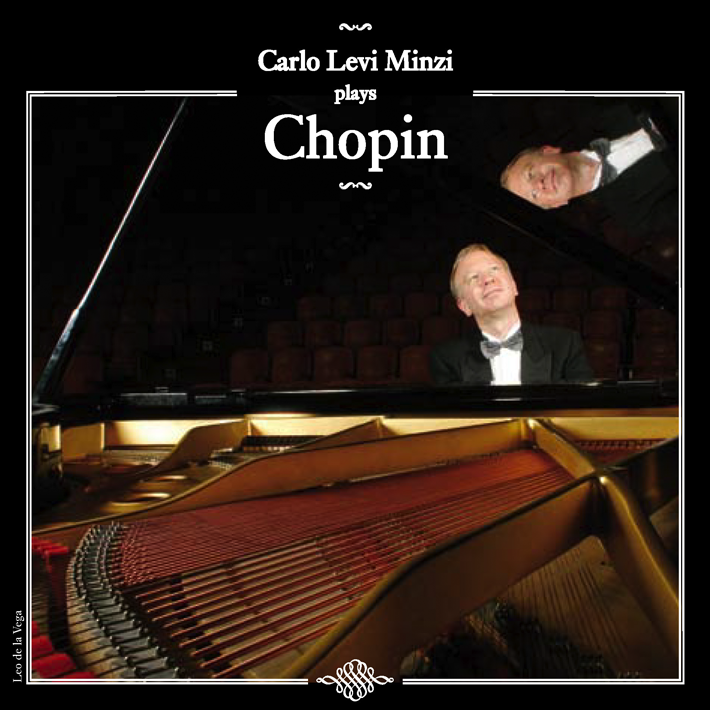| CARLO
LEVI MINZI
E’ Professore Ordinario presso il Conservatorio “G. Verdi” di Milano
ed è stato Visiting Professor presso prestigiose istituzioni europee
e americane. Sein
Repertoire, das von Bach bis zur zeitgenössischen Literatur reicht,
umfasst sämtliche Sonaten von Mozart, Beethoven, Schubert und Skrjabin
und mehr als 50 Konzerte für Klavier und Orchester. Carlo Levi Minzi
ist ordentlicher Professor am Conservatorio “G. Verdi” Mailand.
Zudem ist er häufig “Visiting Professor” exklusiver musikalischer
Stiftungen. Fryderyk Chopin’s 24 Preludes Op. 28 bear more than
a superficial resemblance to Bach’s two sets of preludes and fugues
in the twenty-four major and minor keys. In the Well-Tempered Clavier,
Bach showcased the entire range of his compositional technique,
from the most lyrical to the most learned. Chopin in his Preludes
takes the listener into his compositional workshop, and presents
his most daring and original musical thinking in the briefest and
clearest possible context. It is hard to think of another collection
that so succinctly and so comprehensively presents the full capacity
of classical composition in the tradition that Chopin absorbed from
Bach, Mozart and Beethoven. The first of the set in C major contains
the germ of the entire program. On the surface its sweeping arpeggiation
in the base sounds like a statement of compositional freedom, but
the freedom Chopin establishes in this short piece is far deeper.
Structurally, the C Major Prelude follows a simple antecedent-consequent,
in which a first phrase concluding on the dominant is interrupted,
and the repetition returns us to the tonic. But the consequent that
Chopin has devised to follow his antecedent stretches the meter
to the breaking-point, spinning out a phrase that seems to last
forever. Embedding this “forever” in a few moments of metronome
time is an act of compositional magic. The transformation of time
is emphasized by the diminution of the main motive in the figuration
of the left hand. In contrast to the metrical and figurative freedom
of this first of the set, the fourth Prelude in e minor depicts
a dreadful necessity. As the American theorist Carl Schachter observes
in his 1999 book Unfoldings, Chopin remove the stabilizing tonic
note in the bass from his first statement of the e minor triad.
“If we hear the opening chord as representing a structural tonic,
then we feel the lack of a stabilizing root underneath it, a feeling
that imbues the lowest voice with a strong tendency to descend in
the direction of the missing E.” Schachter adds, “I find it difficult
to contemplate this song for the keyboard without attributing to
it a programmatic character—I hear it as a vision of death, perhaps
the imagination of one’s own death.” The e minor Prelude was played
at Chopin’s request at his funeral. Longing and expectation appear
in an especially poignant fashion in the f minor Prelude (no. 18),
in which the tonic triad is state nowhere except in the final measure.
Yet this tonic is suggested through out by sharp dissonances that
pervade the rapid figuration and point to a goal that is not achieved
until the very end of the work. At these two emotional extremes,
Chopin achieves the desired effect through the rigor of classical
compositional technique. These are not the vignettes of Romantic
salon pieces, but the application the compositional craft of a Bach
or Mozart to the sensibility of mid-19th century Europe. High emotion
and compositional erudition, strict loyalty to form combined with
bold experimentation establish Chopin as one of the tiny number
of absolute masters of classical composition. A prelude implies
something to follow. Unlike Bach, Chopin does not give us fugues
to attend his preludes. Instead, these 24 works are preludes to
Chopin’s whole opus, stylized works that reveal a link between musical
structure and artistic effect across the entire possible range of
the classical style. In the Nocturnes Op. 48, we hear Chopin in
his salon rather in his musical workship, in which the techniques
of composition are hidden away in the folds of a Bellini-like melodic
line. But there is just as much compositional rigor in these works
as in the Preludes. In an overt reference to Bach, both works contain
a chorale as a middle section. And the employment of remote tonalities
shows that the operatic line is only the starting point for the
construction of the composition, a mean to draw the listener into
musical complexity worthy of Bach or Mozart. The Four Mazurkas of
Op. 67 show Chopin at his most deceptively simple. These works were
rescued by Julian Fontana, Chopin’s fellow piano student in Warsaw,
who discovered and published twenty-three previously known compositions
as Opera 66 through 73. In
seinem Buch “Dialoge über die Konsonanz” beschreibt der amerikanische
Musikwissenschaftler David Goldmann auf beispielhafte Weise , dass
Fryderyk Chopin ein würdiger Erbe einer Tradition ist, welche ihren
Ursprung in Bachs Kompositionslehre hat und eine weitere musikgeschichtliche
Entwicklung durch Mozart und Beethoven erfuhr. Diese Anlage wird
auch in offensichtlich romantischen Werken, wie den beiden Nocturne
op. 48 deutlich, in denen sich die harmonische und kontrapunktische
Arbeit hinter einem zerklüfteten melodischen Verlauf verbirgt. Der
Mittelteil beider Stücke ist in wundersamer Art in Choralform komponiert,
ein enger Verknüpfungspunkt zu Bach, der das ohnehin nicht gerade
“einfache Zuhören” noch komplexer gestaltet. Auch in Anlehnung an
Bachs “Ein Musikalisches Opfer”, an Mozarts Fantasie KV 475 und
Beethovens Sonate op. 13 finden wir eine Gegenüberstellung bzw.
ein Zusammenwirken untereinander ferner Tonarten vor, welche den
Schluss einer tiefgreifenden Auseinandersetzung des Komponisten
mit seinen grossen Vorgängern nahelegen. Auch in den vier Mazurken
op. 67 verbirgt sich hinter einer anscheinend einfachen Schreibweise
eine subtile melodisch-harmonische Beziehung, die alles andere als
banal ist. Wir können dem Pianisten Julian Fontana, einem Mitstudenten
Chopins in Warschau dankbar sein, der in den Jahren zwischen 1855-1859
mit dem Einverständnis der Familie Chopins 23 noch unveröffentlichte
Werke, darunter auch diese Mazurken mit den Nummern 66-73 herausbrachte
und sie damit vor der, als letztem Willen des Komponisten gewünschten
Vernichtung bewahrte. Die 24 Präludien op. 28 sind geradezu eine
Bestätigung des eben Gesagten. Im Zeitraum von drei Jahren von 1836-1839
lassen sie sich in den systematischen Kompositionsstil von Bachs
“Wohltemperiertem Klavier” einordnen. Nicht nur wegen der Verwendung
aller 24 Tonarten in Dur und Moll, sondern auch wegen ihrer formalen
Kompaktheit. Die Wiederkehr von Motiven und melodischen Floskeln,
die beim Durchhören des gesamten Werkes auffallen, lassen den Schluss
zu, dass es sich nicht um eine lose Aneinanderreihung einzelner
kontrastierender Stücke handelt, sondern um eine durchkomponierte
Variationsfolge ohne offenkundiges Thema. Man kann daher abschliessend
sagen, dass sich die Grösse Chopins in seiner Erfindungsgabe und
kompositorischen Innovation auf der Basis der bestehenden “mitteleuropäischen
Musiktradition” entfaltete, die dem Genie als einzig möglicher Weg
erschien.
ADD Un breve accenno ... del nuovo CD ... "buon ascolto"
|
 |


